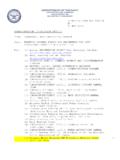Transcription of PROCEDURE MANUAL FOR RESEARCH USING …
1 1 PROCEDURE MANUAL FOR RESEARCH USING sandplay THERAPY AS ORIGINATED BY dora kalff sandplay therapist QUALIFICATIONS It is recommended that sandplay researchers be licensed or under supervision of a licensed therapist with training in sandplay therapy. The researcher s level of licensure, training and years of experience needs to be noted, and he or she must be qualified and in good standing to practice by the appropriate governing board. In addition, it is recommended that researchers have completed a personal process in sandplay therapy, and received adequate training from an STA/ISST approved sandplay teacher. It is also recommended that the researcher holds one of the following credentials: Certification as a sandplay therapist and/or Teacher, sandplay Practioner, Candidate for STA Clinical Membership, or sandplay Therapy Intern.
2 If a researcher does not have any of these credentials, his or her level of training needs to be documented, and their participation in the project justified. ROOM PREPARATION It is recommended that the therapy room have two sand trays available: one with wet sand and one with dry sand. The size of the trays follows the guidelines suggested by dora kalff : inches x inches x inches. Both trays need to be painted blue on the bottom and sides. A pitcher of water should be available to the participant during the session. The collection of miniatures should include objects from the following categories: Nature, Animals, People, Cross Cultural Spiritual/Religious Figures, Vehicles, Structures, Equipment, Objects, Furniture, Natural Elements, Miscellaneous. Further information about the composition of a sandplay collection can be found in Gretchen Hegeman s article The sandplay Collection (Journal of 2 sandplay Therapy, Vol I, No.)
3 2, 1992, ), and Geri Grubbs. (2005). The sandplay Categorical Checklist for sandplay Analysis, Rubedo Publishing; Woodinville, Washington. The sand trays should be located in the same place at the beginning of each session. Ideally the therapist is a short distance away, and sitting in the same location for every session. Any changes or adjustment of this PROCEDURE should be noted. During, or immediately after the sandplay session, the therapist needs to complete the sandplay THERAPY NOTE form (located on p. 6). THERAPEUTIC INTERACTIONS Following dora kalff s guidelines for sandplay therapy, researchers are encouraged to remain silent and be fully present while the participant is working in the sand. If the participant chooses to talk about his or her tray, the researcher is encouraged to listen and take notes, and withhold any interpretations or guided interventions.
4 This gives the individual an opportunity to experience and work through the images on an unconscious level without interference from the researcher. Any necessary verbal response by the researcher to participant s questions or comments, should follow a person-centered, reflective listening model. INITIAL THERAPY SESSION Modifications to these guidelines may be necessary for special populations. These modifications need to be noted in the project protocol and documented by the researcher. 1. During the first therapy session, the researcher needs to explain the PROCEDURE for sandplay therapy with the following statement: This is sandplay therapy. You can make a picture in the sand any way you want, to express yourself in a safe way. 2. The researcher then moves towards the tray to demonstrate while continuing: 3 One tray has dry sand in it, and the other has wet sand.
5 You can move the sand around like this, and shape the sand in the wet tray like this (DEMONSTRATE WHILE TALKING). The trays are blue on the bottom, so you can make a river or a lake like this (DEMONSTRATE). You can also add water to the wet tray if you want. (BE SURE TO SMOOTH THE SAND BACK DOWN BEFORE CONTINUING). You can use as many of the figures as you want from these shelves to create your sand scene. You may or may not have an idea of what you want to do. Choose whatever you are attracted to. Sometimes it will feel like the figures are picking you. There is no right or wrong way to do this. You can do anything you want to express yourself. I will be sitting here quietly while you work, and making a few notes about the figures you pick. If you have a question or need help, just ask.
6 You will have plenty of time, and I ll let you know a few minutes before we need to end. After you leave I will take a picture of your tray. (DECIDE HOW LONG EACH SESSION WILL BE AND GIVE WARNING ABOUT 10 MINUTES BEFORE END OF SESSION. DO NOT DISSEMBLE TRAY WHILE PARTICIPANT IS IN ROOM. PHOTOS ARE TAKEN AFTER PARTICIPANT LEAVES). You can start whenever you are ready. Let me know when you are finished. 3. When the sandplay is complete, stand beside the participant, in front of their tray, and say: Would you like to say anything about your tray? 4. Make a note of what the participant shares. 4 5. After the participant leaves the room, the researcher needs to take the following photos of the tray: 1. Overview from participant s perspective 2. Central area of tray 3.
7 Right and left sides of tray 4. Diagonals and other areas of interest in tray 5. Significant images in tray SUBSEQUENT SESSIONS After the first sandplay session, subsequent sessions need to follow a standardized format that includes: 1. Time for therapeutic check in 2. Invitation to make a sand scene Would you like to do a tray today? 3. Time for participant reflection about his or her tray 4. Researcher s completion of sandplay THERAPY SESSION NOTE 5. Researcher photographing completed sand tray (following above recommendations) HOW TO HANDLE QUESTIONS AND CONCERNS I. When the researcher is not a trained sandplay therapist and new to sandplay , she/he has to be able to follow the suggested procedures for sandplay therapy, and interact comfortably with the participant.
8 Training is recommended. sandplay is based on a non-verbal, intuitive connection of mind, body and spirit. It is important for the researcher to honor this experience for the participant, and in the therapeutic relationship. The therapist needs to remain silently and fully present while the participant creates the sand scene. This creates a free and protected space in which the participant can feel fully accepted. 5 II. If a participant chooses not to make a sandtray during the session, the therapist can proceed with verbal therapy. A client-centered approach is suggested, although this will depend on the design of the researcher. III. If participant begins a conversation with the researcher while working in sand, the researcher should respond in a reflective, client-centered, non-directive manner.
9 Researchers should exhibit restraint with interpretations and therapeutic comments about the participant s work. Questions can be answered simply and directly. RECOMMENDED SESSION DOCUMENTATION I. Each sandplay session should be documented USING the sandplay THERAPY SESSION NOTE form below. The following information should be included: Participant # Date Sand tray # Length of time to complete tray Use of wet or dry tray Type and order of miniatures used by participant Location of miniatures used in tray Position of therapist in relation to the tray Position of client in relations to the tray Behavioral observations during session Use of water Comments of participant while completing tray therapist s comments to participant while completing tray Content of conversation before and/or after working in sand therapist s emotional response throughout session II.
10 In addition, the following photographs of each tray should be taken: 1. Overview from participant s perspective 2. Central area of tray 3. Right and left sides of tray 4. Diagonals and other areas of interest in tray 5. Significant images in tray 6 sandplay THERAPY NOTE FORM sandplay Therapy Note RESEARCH Form Participant ID Number:_____ Date:_____ Sand Tray #: _____ Length of time to complete tray:_____ Dry Tray W et Tr ay Draw tray from client s point of view. Make X outside of square below to indicate where therapist sits in reference to tray. NOTES: Include notes on 1. How client makes tray, 2. Use of water, of selection of items, 4. Any comments that the client makes during or after creating the tray, and 5. therapist s emotional response during the session.







